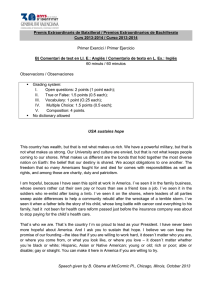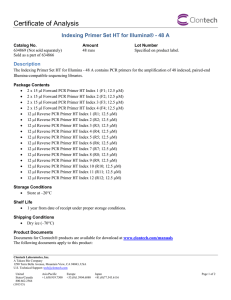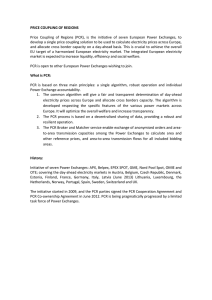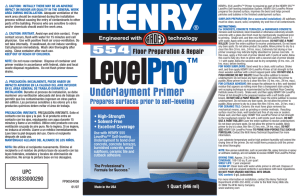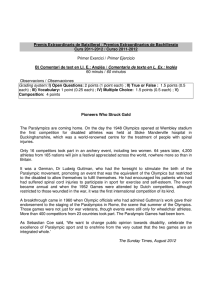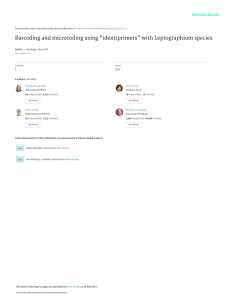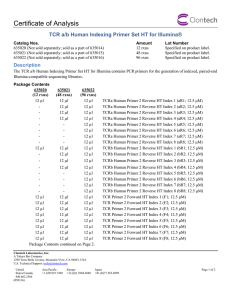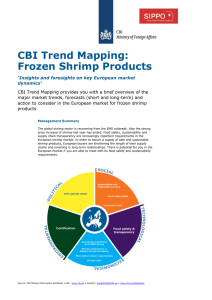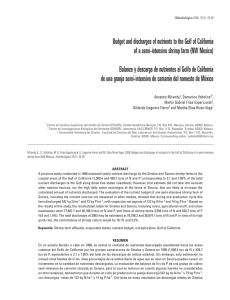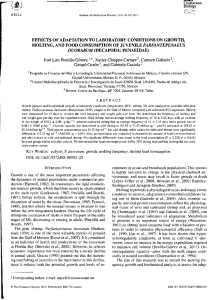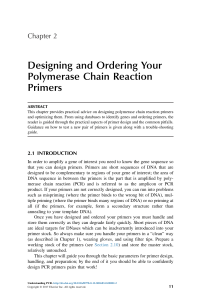Announcement regarding free release of primers for specific
Anuncio
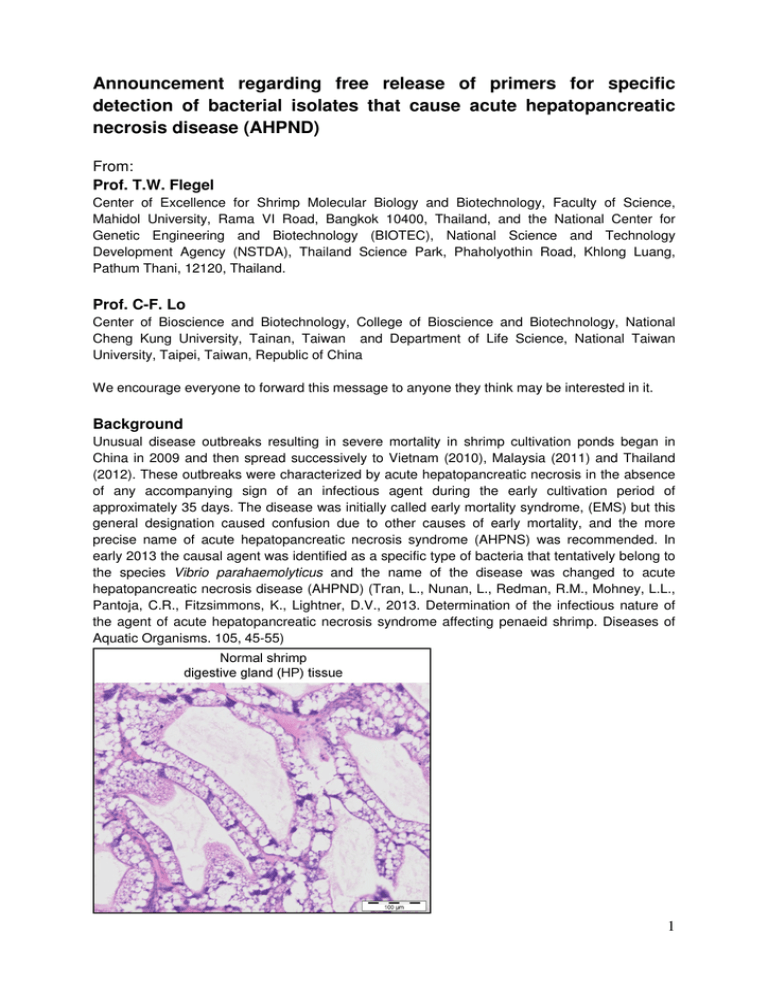
Announcement regarding free release of primers for specific detection of bacterial isolates that cause acute hepatopancreatic necrosis disease (AHPND) From: Prof. T.W. Flegel Center of Excellence for Shrimp Molecular Biology and Biotechnology, Faculty of Science, Mahidol University, Rama VI Road, Bangkok 10400, Thailand, and the National Center for Genetic Engineering and Biotechnology (BIOTEC), National Science and Technology Development Agency (NSTDA), Thailand Science Park, Phaholyothin Road, Khlong Luang, Pathum Thani, 12120, Thailand. Prof. C-F. Lo Center of Bioscience and Biotechnology, College of Bioscience and Biotechnology, National Cheng Kung University, Tainan, Taiwan and Department of Life Science, National Taiwan University, Taipei, Taiwan, Republic of China We encourage everyone to forward this message to anyone they think may be interested in it. Background Unusual disease outbreaks resulting in severe mortality in shrimp cultivation ponds began in China in 2009 and then spread successively to Vietnam (2010), Malaysia (2011) and Thailand (2012). These outbreaks were characterized by acute hepatopancreatic necrosis in the absence of any accompanying sign of an infectious agent during the early cultivation period of approximately 35 days. The disease was initially called early mortality syndrome, (EMS) but this general designation caused confusion due to other causes of early mortality, and the more precise name of acute hepatopancreatic necrosis syndrome (AHPNS) was recommended. In early 2013 the causal agent was identified as a specific type of bacteria that tentatively belong to the species Vibrio parahaemolyticus and the name of the disease was changed to acute hepatopancreatic necrosis disease (AHPND) (Tran, L., Nunan, L., Redman, R.M., Mohney, L.L., Pantoja, C.R., Fitzsimmons, K., Lightner, D.V., 2013. Determination of the infectious nature of the agent of acute hepatopancreatic necrosis syndrome affecting penaeid shrimp. Diseases of Aquatic Organisms. 105, 45-55) 1 Efforts to control AHPND have been hampered by the lack of a specific and rapid detection method that could be used to determine the reservoirs of the causative bacterial isolates, to insure their absence in shrimp broodstock and post larvae, to monitor shrimp during cultivation and to aid research on possible control measures. In Thailand and Taiwan since 2012, our two groups have been conducting cooperative research on possible PCR methods to detect isolates of AHPND bacteria. On 5 December 2013 we obtained the sequence comparison information that allowed us to prepare several test PCR detection methods, and we have spent the last 20 days validating them. Today we are announcing the best method we have found so far. In Thailand, this research has been carried out through cooperation among researchers at Centex Shrimp (Mahidol-BIOTEC cooperative center) and the Department of Public Health both at Mahidol University and the Aquaculture Business Research Center, Faculty of Fisheries, Kasetsart University. The work has been supported since 2011 by contributory funds from many sources including the Agriculture Research Development Agency, the National Research Council of Thailand, the Thai Commission on Higher Education, Mahidol University, the National Science and Technology Development Agency, the Patani Shrimp Farmers Club, the Surathani Shrimp Farmers Club, the Thai Frozen Foods Association, Charoen Pokphand Group, SyAqua Siam Co. Ltd. and Thai Union Group. In Taiwan, the research has also been supported from several sources including the Taiwan National Science Council, National Cheng Kung University (NCKU), National Taiwan University (NTU) and Unipresident Enterprises Corporation. The current economic situation in the shrimp culture industry in Asia is critical and daily losses due to direct shrimp mortality or due to suspended cultivation are enormous. In the recent past, the average production of cultivated shrimp in Thailand has been in the range of 30-50 thousand metric tons monthly. At a farm-gate value of approximately 100 to 200 baht per kg, this amounts to 3,000-5,000 million baht per month and 100-167 million baht per day. Based on our past experience with maximum yearly revenue from royalties for our most successful detection kit (US$10,000 per year = 320,000 baht), even 10 years of such revenue (3.2 million baht) would cover only a small percentage of the current losses for one day. Therefore, we believe that every single day of reduction in the risk of AHPND outbreaks will benefit Thailand far in excess of any possible return on research expenditures that might be envisioned by collection of royalties for our discoveries. To implement intellectual property protection, delays amounting to several 2 weeks or months would be needed to prepare documents for a patent application, to negotiate licenses and to prepare and market commercial detection kits in a sufficient volume to satisfy the market demand. To these considerations must be added the complex nature of the funding for our research and the further delays that would thus arise in negotiating a mutually agreeable license fee and appropriate percentage of royalties among the funders and participants. We cannot justify the cumulative potential economic losses that might occur from delays of days, weeks or months. For these reasons, we have decided to release, free for public access, detailed information on the sequences and protocols from our research for a PCR detection method for AHPND bacteria. This will allow for their wide and rapid dissemination and allow interested stakeholders to assess the efficacy in developing possible measures to reduce the risk of AHPND outbreaks. Although we have tested the specificity of these methods for AHPND bacteria, the number of samples used was relatively small. Briefly, we found that: 1. The two primer sets gave the same positive and negative results on 67 out of 68 samples tested. The 1 exceptional sample gave a positive result with set AP1 and negative with AP2. 2. Out of 14 samples of pooled hepatopancratic tissue (10 shrimp from each pond) from an FAO study in Vietnam used for metagenomics analysis, 8 samples deemed positive by histopathology gave 5 positive and 3 negative results with both primer sets while 5 samples deemed negative by histopathology all gave negative results with both primer sets. 3. The 68 tests included 5 bacterial isolates that were identified as V. parahaemolyticus and were proven to cause AHPND histopathology in bioassays. All gave positive results with both primer sets while 3 isolates obtained from shrimp pond sediment in 2002 and proven not to cause AHPND or shrimp mortality in bioassays gave negative results with both primer sets. So did two other isolates from shrimp pond water and shrimp meat from 2002, although they have not yet been tested in bioassays. 4. One isolate that did not give AHPND histopathology in bioassays but did give severe mortality with abnormal histology of the hepatopancreas gave positive results with both primer sets. 5. Isolates of Shewanella, Rhodococcus, Leifsonia, Delftia, Ralstonia, V. vulnificus, V. harveyi, V. alginolyticus and B. subtilis gave negative results with both primer sets. Thus, we cannot guarantee that the methods described will give no cross reactions with every possible non-AHPND bacterium or with any other possible organism. Nor can we guarantee that the methods will successfully detect every bacterial isolate capable of causing AHPND. We invite all stakeholders to help us in further validating these new detection methods. Our preliminary sequence assembly and sequence comparison analysis suggest that the target sequences that we have identified originate from plasmid DNA and not from the chromosomal DNA of the AHPND isolates we used. If this assumption is confirmed, it will have implications regarding virulence transmission mechanisms. For example, AHPND has been shown by Loc Tran et al. to be caused by a bacterial toxin(s), and the toxin may be a protein coded by the plasmid DNA that our PCR method targets. However, the best PCR detection method would consist of the coding sequence for the toxin itself since sequences of related plasmids may vary and some may not all carry the toxin gene. However, the time needed for research to identify the toxin is unpredictable. Since the situation is urgent, we have decided to release this preliminary information in the hope that it will serve as an interim detection tool until the toxin is identified. We hope that release of our method will aid in accelerating the study of transmission 3 mechanisms and control measures for AHPND. We would be grateful if those who use these primer sets would inform us of their efficacy or problems encountered upon their use. Our best wishes to everyone for a happy holiday season at the end of 2013 and a happy, healthy and prosperous 2014. PCR protocols for detection of AHPND bacteria from cultures or infected shrimp In addition to the methods described in detail below, methods have been tested to give shorter amplicons directly or by nested PCR from the ~700 bp targets given. However, these methods gave rise to many false positive results and so, such modifications are not recommended. For the AP1 and AP2 methods that both yield amplicons of ~700 bp the protocols are as follows. The DNA from infected shrimp stomach or hepatopancreatic tissue or from bacterial isolates was extracted by a general DNA extraction method. The amount of template DNA in the 25 µl PCR reaction volume was in the range of 0.01-1 ng of DNA extracted from bacterial isolates or in the range of 10-100 ng of total DNA extracted from shrimp tissues. Two primer sets [AHPND primer set 1, (AP1) and AHPND primer set 2 (AP2)] were used for the amplification of AHPND bacterial DNA fragments. The following are the sequences of the two forward (F) and reverse (R) primer sets: AP1F, 5’- CCT TGG GTG TGC TTA GAG GAT G -3’; AP1R, 5’- GCA AAC TAT CGC GCA GAA CAC C -3’; and AP2F, 5’- TCA CCC GAA TGC TCG CTT GTG G -3’; AP2R, 5’- CGT CGC TAC TGT CTA GCT GAA G -3’. The cycling reactions were conducted for 5 min at 94°C, followed by 25~30 cycles of 30 sec denaturation at 94°C, 30 sec annealing at 60°C and 60 sec extension at 72°C, plus a final 10 min extension at 72°C. The amplified PCR products were analyzed in 2 % agarose gels, stained with ethidium bromide, and visualized under ultraviolet transilluminatlon. The AHPND positive samples gave a positive band at approximately 700 bp while the non-AHPND samples give no band. With respect to positive controls for the AP1 and AP1 methods, those interested may contact us and we will send two plasmids carrying inserts of the target sequences as blots on filter paper by ordinary air mail. These can be eluted from the paper and used to transform E. coli for a perpetual supply. PCR protocol Pre-heat: 94°C, 5min PCR 25~30 cycles with: Denaturation: 94°C, 30 sec Annealing: 60°C, 30 sec Extension: 72°C, 60 sec Final extension: 72°C, 10 min Amplicon: ~700 bp PCR primers and target sequences AHPND Primer set 1 (AP1) AHPND Primer set 1 Forward (AP1F) - 5’- CCTTGGGTGTGCTTAGAGGATG -3’ AHPND Primer set 1 Reverse (AP1R) - 5’- GCAAACTATCGCGCAGAACACC -3’ AP1 Amplicon- 700 bp 4 CCTTGGGTGTGCTTAGAGGATGATGAAGATGACTATGTCCTCGAACGATTTGAGTTGCGAG TTCACGGTCGTAAACCACTCGTTCTCAATCGCCCCTCGTTTTCCAAACTCATGTTCGTCACC CAGCAGTATCTCCACACGTCACAGGAAACCACCAAGCGAATATTAAGAGCCACCATCTTAGA AAGTGCTGAGCCCTTCACGGCGGATGAACACTGCCGATTGGTCTCTGCACTCGAAAGGCAC TTAGCTGACGTCCATGAATGAAAAAACCCGATAACATCATCATGTTATCGGGCTATTTGGTG TCATCAGTGTGTTTGTGTTTGGCGGTTTTACAACCATTCTTCAGCACATTCATGTGTTATCGC ATCAGTGGTTTCAGTGATCGTGGCAGACTGAAACCCGCCGACGATGGGATTTAACGCTAAA TTCGCTACTCTCTTCGCCTCATCAAAGCAAGGAAGCACTGCAACGTACTCCTTACCCCAACT CACTTCAAGCGTAACTCGGCAAGCACCTTTATACCCAACCGAAACATGAACTTCTGCATCAA GCCGGTGTTCATCGCCGTTCAATAATGAATTCATCAGCGCGCCCTCGTTAAAGAGCATTAGA AGTGATGCACTGGAATGTTAAACCAACACACCAATGCATCGTAGAACGCCGAAATAACAGG GTGTTCTGCGCGATAGTTTGC AHPND Primer set 2 (AP2) AHPND Primer set 2 Forward (AP2F) - 5’- TCACCCGAATGCTCGCTTGTGG -3’ AHPND Primer set 2 Reverse (AP2R) - 5’- CGTCGCTACTGTCTAGCTGAAG -3’ AP2 Amplicon sequence 700 bp TCACCCGAATGCTCGCTTGTGGCTCAGCGAGCATGGGGTCACGCCTCTATAAGTGCAAAAA CTCTGGCTGTACCTACTACACCAAATACCTCAATCAAAGCTGTAAGTCTCGAGCTTGCTGCA GTGGTGGCGTCAAATCCACCGAAAGGTGGATGGTTGCTTAATCGATTATTCAAATGCGCGT CCAACATTTTAACGACTTGGGCGAAACGGCAAGACTTAGTGTACCCAGAGCCAAAACCTCAT CGAAAATCAGGATTGTTGCTTCCTACGTTGAAAGACCGGCGTTATCAGCTTCATATCCCCCA CCTCTGTCACGCCTGCGTGGATCGCTGAATGACTGTAAAAAATGACAATAAAGATTGATCAA TCTCAGAAACGTTTTGGGACAAAAATGGTTCAACAATATCTGCTGGGTATGTGGCTATCCAA ACAATATTCTTGATAAAGGCTGGGAAATGGAAAATTCACTCTCCAAATACACCAAATTAGTAC AGAAATTTATACAATTACAGTAACATGAATCCGTCATACTGGCAGCAAGGAGTTCATGTGAG CCAACAAGAAGAAAAATACCCGGCCAGCGCCATATCCTCCTGGAGCGGCTTTGTTTACCAA GGAAAAGTCGCACTATATCACTCACTTAAGCTTATTCTCGATGATGATTTGGACTTCGAACTT CAGCTAGACAGTAGCGACG 5 6
